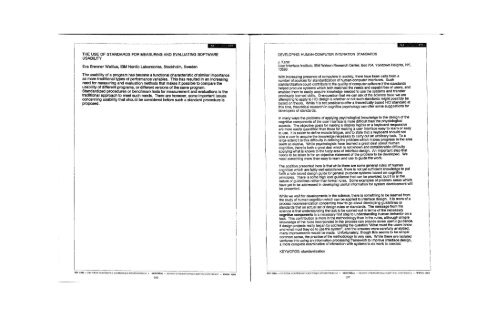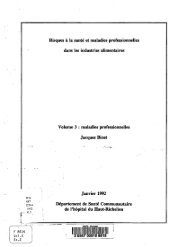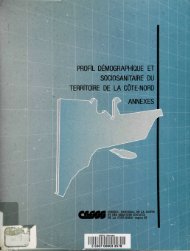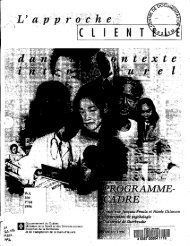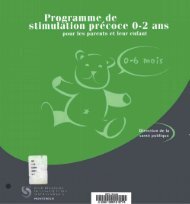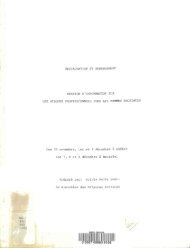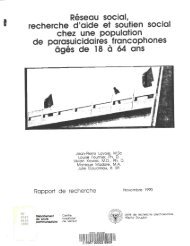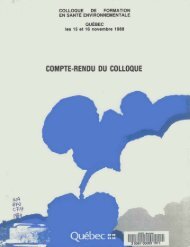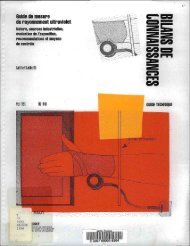le travail à l'écran de visualisation work with display units
le travail à l'écran de visualisation work with display units
le travail à l'écran de visualisation work with display units
You also want an ePaper? Increase the reach of your titles
YUMPU automatically turns print PDFs into web optimized ePapers that Google loves.
THE USE OF STANDARDS FOR MEASURING AND EVALUATING SOFTWAREUSABILITYEva Brenner Wallius, IBM Nordic Laboratories, Stockholm, Swe<strong>de</strong>nThe usability of a program has become a functional characteristic of similar importanceas more traditional types of performance variab<strong>le</strong>s. This has resulted in an increasingneed for measuring and evaluation methods that makes it possib<strong>le</strong> to compare theusability of different programs, or different versions of the same program.Standardized procedures or benchmark tests for measurement and evaluations is thetraditional approach to meet such needs. There are however, some important issuesconcerning usability that should be consi<strong>de</strong>red before such a standard procedure isproposed.DEVELOPING HUMAN-COMPUTER I NTE RATI ON STANDARDSJ KaratUser Interface Institute, IBM Watson Research Center, Box 704, Yorktown Heights, NY,10598With increasing presence of computers in society, there have been calls from anumber of sources for standardization of human-computer interfaces. Suchstandardization could contribute to the quality of computer software if the standardshelped produce systems which both matched the needs and capabilities of users, an<strong>de</strong>nab<strong>le</strong>d them to easily acquire know<strong>le</strong>dge nee<strong>de</strong>d to use the systems and transferpreviously <strong>le</strong>arned skills. One question that we can ask of the science base we areattempting to apply to HCI <strong>de</strong>sign is whether or not such standards might possibly bebased on theory. Whi<strong>le</strong> it is not possib<strong>le</strong> to offer a theoretically based HCI standard atthis time, theoretical research in cognitive psychology can offer some suggestions for<strong>de</strong>velopers of standards.In many ways the prob<strong>le</strong>ms of applying psychological know<strong>le</strong>dge to the <strong>de</strong>sign of thecognitive components of the user interface is more difficult than the physiologicalaspects. The objective goals for making a <strong>display</strong> <strong>le</strong>gib<strong>le</strong> or a keyboard responsiveare more easily quantified than those for making a user interface easy to <strong>le</strong>arn or easyto use. It is easier to <strong>de</strong>fine musc<strong>le</strong> fatigue, and to state that a keyboard should nottake a user to acquire the know<strong>le</strong>dge necessary to carry out an arbitrary task. To alarge extent it is this difficulty in <strong>de</strong>fining the prob<strong>le</strong>m which makes progress in the areaseem so elusive. Whi<strong>le</strong> psychologists have <strong>le</strong>arned a great <strong>de</strong>al about humancognition, there is both a great <strong>de</strong>al which is not known and consi<strong>de</strong>rab<strong>le</strong> difficultyapplying what is known to the fuzzy area of interface <strong>de</strong>sign. An important step thatneeds to be taken is for an objective statement of the prob<strong>le</strong>m to be <strong>de</strong>veloped. Weneed something more than easy to <strong>le</strong>arn and use to gui<strong>de</strong> the <strong>work</strong>.The position presented here is that whi<strong>le</strong> there are some general ru<strong>le</strong>s of humancognition which are fairly well established, there is not yet sufficient know<strong>le</strong>dge to putforth a ru<strong>le</strong> based <strong>de</strong>sign gui<strong>de</strong> for general purpose systems based on cognitiveprincip<strong>le</strong>s. There is some high <strong>le</strong>vel guidance that can be provi<strong>de</strong>d, but it is in thenature of gui<strong>de</strong>lines rather than formal ru<strong>le</strong>s. Some examp<strong>le</strong>s of prob<strong>le</strong>m areas whichhave yet to be addressed in <strong>de</strong>veloping useful information for system <strong>de</strong>velopment willbe presented.Whi<strong>le</strong> we wait for <strong>de</strong>velopments in the science, there is something to be <strong>le</strong>arned fromthe study of human cognition which can be applied to interface <strong>de</strong>sign. It is more of aprocess recommendation concerning how to go about <strong>de</strong>veloping gui<strong>de</strong>lines orstandards that an actual set of <strong>de</strong>sign ru<strong>le</strong>s or standards. The message from thescience is that un<strong>de</strong>rstanding the task to be carried out in terms of the necessarycognitive components is a necessary first step to un<strong>de</strong>rstanding human behavior on atask. This contribution is more in the methodology than in the ru<strong>le</strong>s, although simp<strong>le</strong>know<strong>le</strong>dge of the ru<strong>le</strong>s incorporated in the process can provi<strong>de</strong> some useful guidance.If <strong>de</strong>sign projects really began by addressing the question "What must the users knowand what must they do to use the system", and the answers were carefully analyzed,many improvements would be ma<strong>de</strong>. Unfortunately, though this seems to be simp<strong>le</strong>common sense, the practice of the methodology is very rare. Whi<strong>le</strong> there are isolatedventures into using an information processing frame<strong>work</strong> to improve interface <strong>de</strong>sign,a more comp<strong>le</strong>te examination of interaction <strong>with</strong> systems to do <strong>work</strong> is nee<strong>de</strong>d.KEYWORDS: standardizationTEV 1989 — DEUXIÈME CONFÉRENCE SCIENTIFIQUE INTERNATIONALE • MONTRÉAL • SECOND INTERNATIONAL SCIENTIFIC CONFERENCE — WDU 1989196TEV 1989 — DEUXIÈME CONFÉRENCE SCIENTIFIQUE INTERNATIONALE • MONTREAL • SECOND IN'ITiRNATIONAI. SCIENTIFIC CONFERENCE — WWDU 1989193


